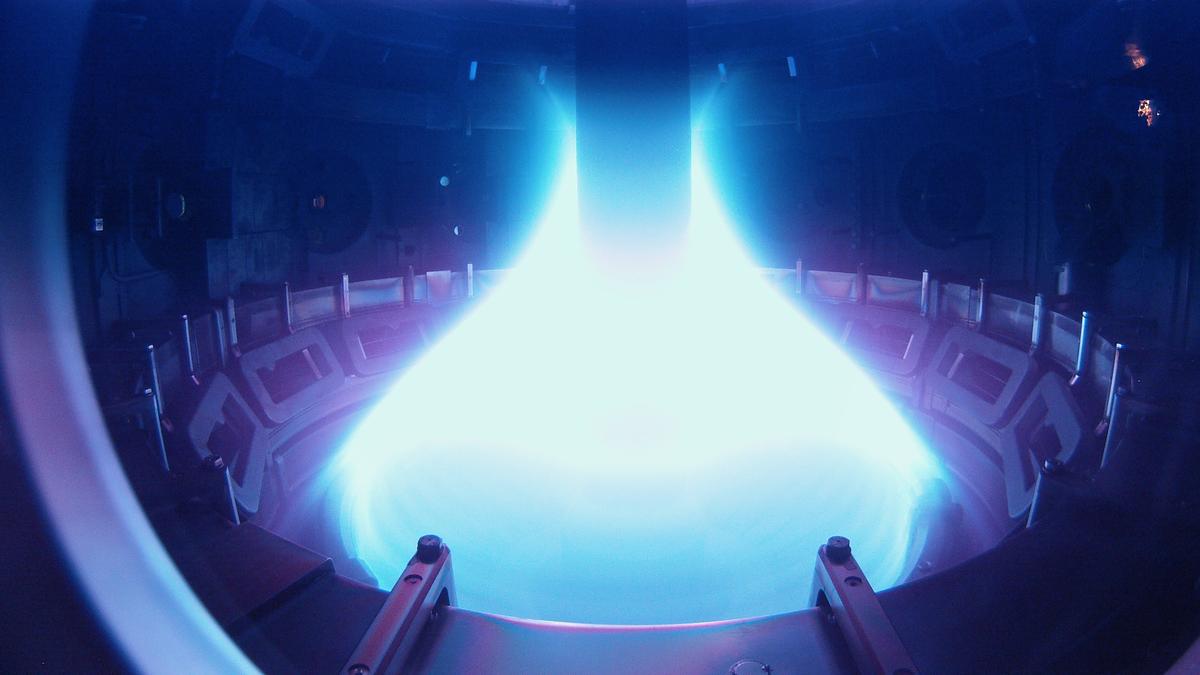Researchers at the Institute for Plasma Research (IPR) in Gandhinagar have laid out a roadmap for India to achieve fusion power.
They envisage developing India’s first fusion electricity generator, called the Steady-state Superconducting Tokamak-Bharat (SST-Bharat), with a power output 5x the input. According to the team, it will be a fusion-fission hybrid reactor with 100 MW of the total 130 MW provided by fission. The estimated construction cost is Rs 25,000 crore.
The team ultimately aims to commission a full-scale demonstration reactor by 2060 with an ambitious output-to-input power ratio of 20 and to generate 250 MW.
Fission to fusion
“Fusion is the process where two small, light atoms come together to form a bigger, heavier atom. When this happens, a huge amount of energy is released,” Daniel Raju, Dean of academics and student affairs at IPR and lead author of the new study, said.
Nuclear fusion is the reason stars exist and produce heat and light.
For decades, fission reactors have provided the backbone for nuclear power. Fusion however is more attractive than fission because it produces less radioactive waste, eliminating many (but not all) of the costs and headaches of storing hazardous material.
Controlled fusion can only happen in extreme physical conditions, the kinds that exist in the belly of a star. There are currently two popular ways to achieve this: inertial confinement and magnetic confinement. Inertial confinement uses powerful lasers to blast a capsule with X-rays to initiate fusion. Magnetic confinement works by recreating some of the conditions inside stars.
India is already invested in magnetic confinement as a member of the International Thermonuclear Experimental Reactor (ITER) project, which is building a large reactor in France. In this method, scientists heat plasma to 100 million degrees C, then gently guide the nuclei with magnetic fields until they fuse. To compare, temperatures in the sun’s core reach 15 million degrees C.
Maintaining the plasma
The ratio of the output power to the input, called the Q value, determines efficiency.
“We need Q to be much greater than 1, meaning the reactor gives us more energy than we use to run it. Right now, the best result has come from the Joint European Torus in the UK, which got about 0.67, that is 67% of the energy back,” Raju said.
ITER aims to achieve a Q of 10. Future fusion power plants are expected to achieve a value of 20 to be commercially feasible.
The doughnut-shaped reactor vessel in which fusion happens is called a tokamak. Its success is measured by how long it can hold the plasma together without dissipating.
“The longer we can hold it, the closer we get to continuous and reliable fusion reactions,” Raju said.

In February 2025, the WEST tokamak in France maintained plasma for a record 22 minutes. The current state-of-the-art in India is the SST-1 tokamak at IPR. According to Raju, “It has managed to produce plasma for about 650 milliseconds and it’s designed to go up to 16 minutes.”
SST-1 is a research machine and not meant to generate electricity. SST-Bharat is presented as the next step beyond this experimental base.
Digital twinning
To strengthen the new roadmap, the researchers have proposed digital twins — virtual replicas of physical systems that mimic real-time conditions inside a tokamak. This would allow scientists to test new designs and troubleshoot before building them physically. They also suggest machine learning-assisted plasma confinement and programmes to develop radiation-resistant materials. These innovations are still at an early stage, but the roadmap has argued they are critical to making progress.
Globally, however, timelines remain uncertain. The UK’s STEP programme aims for a prototype fusion plant by 2040. Several US private firms claim they will demonstrate grid-connected fusion as early as the 2030s. China’s EAST tokamak has already set records for plasma duration. India’s target of 2060 places it on a longer path — one that may be less competitive but more cautious.
Funding and policy are also crucial. While the EU and US are investing billions of dollars in fusion R&D and private start-ups, India’s budgets remain modest and almost entirely public-sector driven. The absence of Indian private-sector engagement stands out when compared with the global boom in fusion start-ups. Within India’s wider energy policy, fusion also competes with pressing commitments: net zero by 2070, major expansions in solar and wind, and a long-standing nuclear fission programme.
Rough terrain
M.V. Ramana, Simons Chair in Disarmament, Global and Human Security at the University of British Columbia, also struck a note of caution.
“Timelines in nuclear fusion are never realistic and often not achievable,” he said.

He also pointed out that the economic viability of fusion power is unproven: “The unstated assumption is that electrical power from this process will be affordable at some future date. There is no reason to expect that to be the case.”
Raju himself acknowledged the cost challenge: “The economic viability of fusion energy will certainly face a huge challenge while competing with fission and other energy sources due to costs in R&D, construction, and operations.”
Even if commercial viability remains elusive, the researchers argued that fusion R&D will produce dividends in other areas, including radiation-hardened materials, superconducting magnets, plasma modelling, and high-temperature engineering. These capabilities have strategic value, potentially upgrading Indian industry and strengthening technological autonomy. Partnerships with ITER and global firms may also spark innovation and bring project management expertise into Indian labs.
“Since its [commercial viability hasn’t been demonstrated so far], we are aware that it would be difficult to push it as a potential source of energy in the near future,” Raju said. “Since a lot of private [entities], start-ups and government bodies across the world are jumping into fusion energy, it makes sense for us to go with optimism and align our domestic fusion energy programmes with the world.”
Unnati Ashar is a freelance science journalist.
Published – September 24, 2025 05:30 am IST
